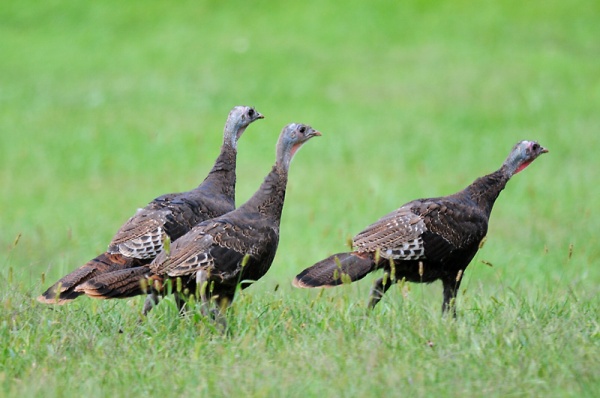
Around the world, national birds are chosen from among large, distinctive or iconic native species. The bald eagle was chosen in 1782 for the Great Seal of the United States. He is naturally large and distinctive and, after hundreds of years of persecution (yes, people used to trap and kill bald eagles) the 1940 Bald Eagle Protection Act made him completely iconic.
Many national birds are not majestic. Austria and Estonia have both chosen the barn swallow and the U.K. has chosen the European robin. The U.S. could have chosen the large, native wild turkey (Meleagris gallopavo). After all France, our great supporter during the American Revolution, chose the Gallic rooster (Gallus gallus) as their symbol but that was largely due to a play on words. Gallus is the Latin name for both the Gauls and the chicken.
Some say Ben Franklin preferred the wild turkey over the bald eagle as a national symbol but the real story is more nuanced than that. It’s a story of our first principles and the fight for independence.
Our basic reason for fighting the War of Independence was Americans’ desire to be freed of England’s hereditary aristocracy (the king) who imposed oppressive laws from afar. The leaders of our Revolution were not hereditary aristocrats. They were generally “commoners” who became successful on this continent. They resented being pushed around by the aristocrats overseas.
As the war was winding down in 1783, Major General Henry Knox proposed that the leaders keep in touch so they formed the exclusive Society of the Cincinnati and chose the bald eagle as their symbol. Open only to those who fought or lead the American Revolution and their descendants, the Society’s bylaws formed the first hereditary aristocracy on American soil.
This was offensive to Benjamin Franklin. What did we just spend eight years fighting for?! In a letter to his daughter he criticized the Society and pretty much “dissed” everything they stood for including their odd depiction of a bald eagle on their crest. He said that it looked like a wild turkey and then he let lose on the bald eagle and riffed on the turkey’s “better” qualities. It’s a great piece of writing and well worth a read (click here). By the way, Franklin is correct about the bald eagle’s rapacious habits.
Ben Franklin’s and judge Aedanus Burke’s distaste for the Society’s bylaws turned public opinion against them. George Washington threatened to resign as the Society’s president unless they removed the hereditary clause — which they did until the furor died down. Then they secretly returned to the rule of primogeniture, membership inheritance by the first-born males. (“Hmmm!” says this first-born female.)
More than 200 years later, the Society of the Cincinnati still exists but is so obscure that few of us have heard of it. Their lasting legacy is the name of Cincinnati, Ohio and the misconception that Ben Franklin preferred turkeys.
(photo of wild turkeys by Steve Gosser)
p.s. The Society of the Cincinnati has other lasting legacies but few of us know what they are. While writing this article I learned for the first time that Society members played a role in the development of Pittsburgh and that Arthur St. Clair (i.e. Upper St. Clair) was a member. Who knew?
I just finished rereading “His Excellency: George Washington” by Joseph J. Ellis and learned (again) about the Society of the Cincinnati. Many things about his second term sound like “today”. Ellis’ style is very readable and tells a lot about how we got to be who we are as a nation and a people.
Have to admit that I love the number in 1776 where Franklin, Jefferson, & Adams ‘debate’ the selection of the national bird. So clever (even if playing fast and loose with the facts…)
Fascinating stuff…I can relate to Ben’s testimony that the turkey is a “Bird of Courage, and would not hesitate to attack a Grenadier of the British Guards who should presume to invade his Farm Yard with a red Coat on”. I often have a tom approach my black Suzuki menacingly when I visit my parents’ home!